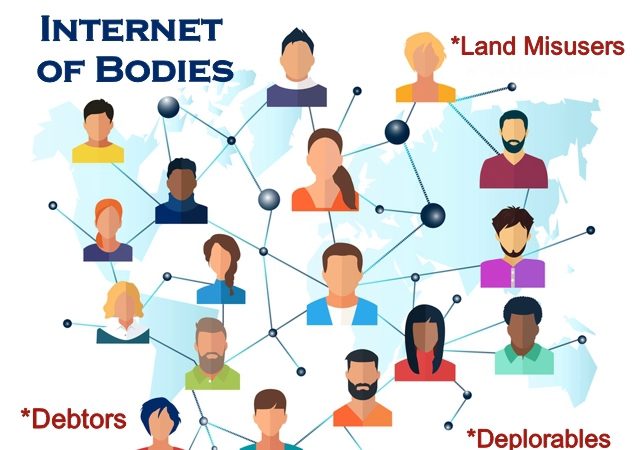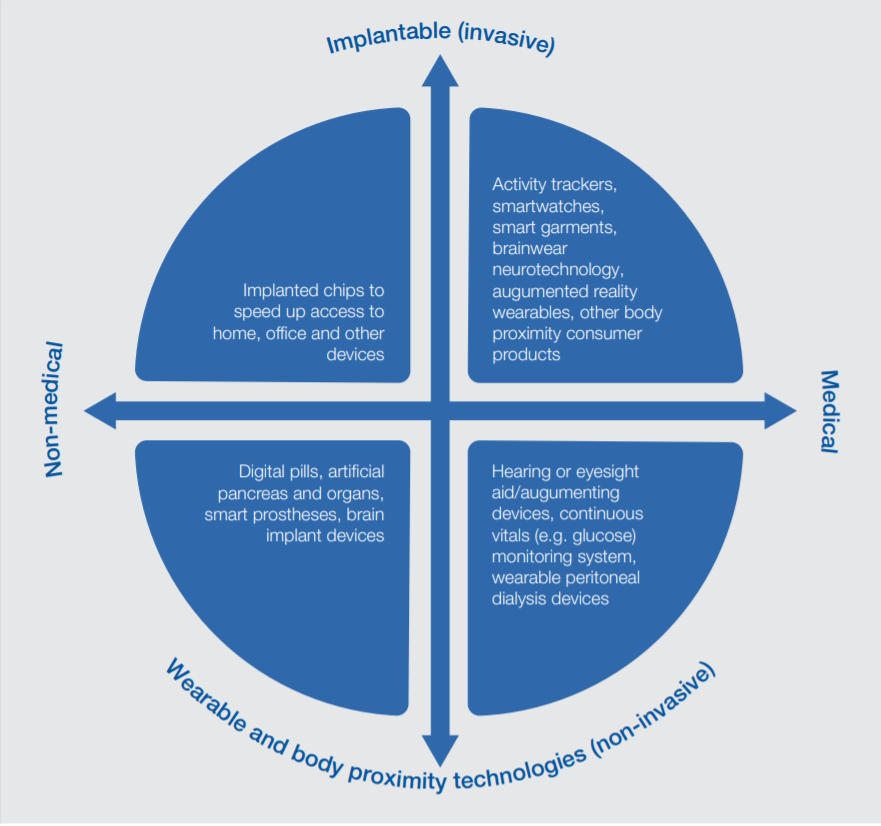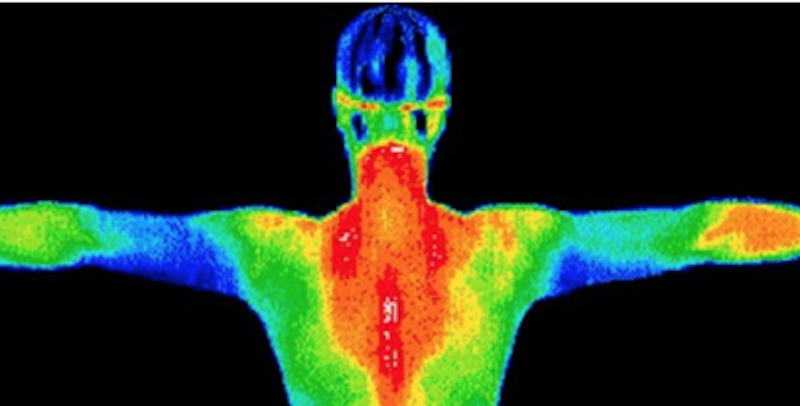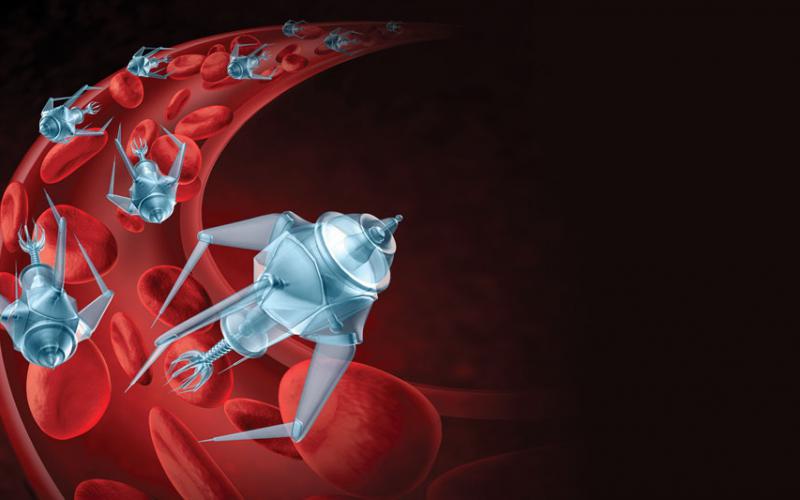When I was in the Healthcare Industry, I saw first hand how the New World Order was going to use Healthcare to implement their Total Control. Through the electronic healthcare system, they can force you to comply with their plan for YOUR health. They can prevent you from working if you do not comply. They can force you into a facility. They can take your children away. They can label you unfit. They can cause you to be refused a bank account or credit card. They can and will have you executed… by guillotine, so as not to ruin the precious organs in your body which they have already counted in their inventory.
I had no idea that it could get even worse than that. BUT, oh yes it can. The horrors that will be brought about through nanotechnology are terrifying. And once you are inhabited by this technology, you are no longer human. You are lost forever, and forever at the mercy of the overlords.
Internet of Things, Internet of Bodies, Internet of Nanotechnology, Internet of Thought, Internet of US. BREAK FREE FROM THE NET! Before it is too late!
spacer
Image: © Siarhei /Stock.adobe.com
A team has proposed using nanobots to create the ‘internet of thoughts’, where instant knowledge could be downloaded just by thinking it.
An international team of scientists led by members of UC Berkeley and the US Institute for Molecular Manufacturing predicts that exponential progress in nanotechnology, nanomedicine, artificial intelligence (AI) and computation will lead this century to the development of a human ‘brain-cloud interface’ (B-CI).
Writing in Frontiers in Neuroscience, the team said that a B-CI would connect neurons and synapses in the brain to vast cloud computing networks in real time.
Such a concept isn’t new with writers of science fiction, including Ray Kurzweil, who proposed it decades ago. In fact, Facebook has even admitted it is working on a B-CI.
However, Kurzweil’s fantasy about neural nanobots capable of hooking us directly into the web is now being turned into reality by the senior author of this latest study, Robert Freitas Jr.
This new concept proposes using neural nanobots to connect to the human brain’s neocortex – the newest, smartest, ‘conscious’ part of the brain – to the ‘synthetic neocortex’ in the cloud. The nanobots would then provide direct, real-time monitoring and control of signals to and from brain cells. “These devices would navigate the human vasculature, cross the blood-brain barrier and precisely auto-position themselves among, or even within, brain cells,” explained Freitas. “They would then wirelessly transmit encoded information to and from a cloud-based supercomputer network for real-time brain-state monitoring and data extraction.”
Things get even wilder when you consider the fact that this could allow for a Matrix-style ability to download reams of information into the brain. The B-CI could even enable us to create a future ‘global superbrain’, according to the team, connecting networks of human brains and AI to form a hive mind.
Dr Nuno Martins, lead author of this latest research, said such mass collective thought could revolutionise humankind. “This shared cognition could revolutionise democracy, enhance empathy and ultimately unite culturally diverse groups into a truly global society,” he said. (what society?? We would all be one lump. That is not society.)
Unsurprisingly, it’s not that simple
Looking at what the challenges are for a working B-CI, the team sees the transfer of neural data to and from supercomputers in the cloud as being the biggest stumbling block.
“This challenge includes not only finding the bandwidth for global data transmission,” (the real reason for 5G, and you thought they were just trying to help you upload your stream faster.) Martins said, “but also how to enable data exchange with neurons via tiny devices embedded deep in the brain.”
A potential workaround proposed by the team includes magnetoelectric nanoparticles that could amplify this communication, something that has already worked in testing with mice. However, how to actually get these nanorobots into the brain safely is considered the project’s greatest challenge.
“A detailed analysis of the biodistribution and biocompatibility of nanoparticles is required before they can be considered for human development,” Martins added. “Nevertheless, with these and other promising technologies for B-CI developing at an ever-increasing rate, an ‘internet of thoughts’ could become a reality before the turn of the century.”
AI and Nanotechnology Team Up to bring Humans to the brink of IMMORTALITY, top scientist claims

IMMORTAL: Human beings could soon live forever
HUMAN beings becoming immortal is a step closer following the launch of a new start-up.
Dr Ian Pearson has previously said people will have the ability to “not die” by 2050 – just over 30 years from now.
Two of the methods he said humans might use were “body part renewal” and linking bodies with machines so that people are living their lives through an android.
But after Dr Pearson’s predictions, immortality may now be a step nearer following the launch of a new start-up.
Human is hoping to make the immortality dream a reality with an ambitious plan.
Josh Bocanegra, the CEO of the company, said he is hoping to use Artificial Intelligence technology to create its own human being in the next three decades.
He said: “We’re using artificial intelligence and nanotechnology to store data of conversational styles, behavioural patterns, thought processes and information about how your body functions from the inside-out.
Live to 2050 and “Live Forever” Really?
“This data will be coded into multiple sensor technologies, which will be built into an artificial body with the brain of a deceased human.
“Using cloning technology, we will restore the brain as it matures.”
Last year, UK-based stem cell bank StemProject said it could eventually potentially develop treatments that allow humans to live until 200.
Mark Hall, from StemProtect, said at the time: “In just the same way as we might replace a joint such as a hip with a specially made synthetic device, we can now replace cells in the body with new cells which are healthy and younger versions of the ones they’re replacing.
“That means we can replace diseased or ageing cells – and parts of the body – with entirely new ones which are completely natural and healthy.”
Watch Dr. Ian Pearson Talk About the Possibility of Immortality by 2050
Nanotech could make humans immortal by 2040, futurist says
Ray Kurzweil says nanobots will soon wipe out cancer, back up memories and slow aging
In 30 or 40 years, we’ll have microscopic machines traveling through our bodies, repairing damaged cells and organs, effectively wiping out diseases. The nanotechnology will also be used to back up our memories and personalities.
In an interview with Computerworld, author and futurist Ray Kurzweil said that anyone alive come 2040 or 2050 could be close to immortal. The quickening advance of nanotechnology means that the human condition will shift into more of a collaboration of man and machine, as nanobots flow through human blood streams and eventually even replace biological blood, he added.
That may sound like something out of a sci-fi movie, but Kurzweil, a member of the Inventor’s Hall of Fame and a recipient of the National Medal of Technology, says that research well underway today is leading to a time when a combination of nanotechnology and biotechnology will wipe out cancer, Alzheimer’s disease, obesity and diabetes.
It’ll also be a time when humans will augment their natural cognitive powers and add years to their lives, Kurzweil said.
“It’s radical life extension,” Kurzweil said. “The full realization of nanobots will basically eliminate biological disease and aging. I think we’ll see widespread use in 20 years of [nanotech] devices that perform certain functions for us. In 30 or 40 years, we will overcome disease and aging. The nanobots will scout out organs and cells that need repairs and simply fix them. It will lead to profound extensions of our health and longevity.”
Of course, people will still be struck by lightning or hit by a bus, but much more trauma will be repairable. If nanobots swim in, or even replace, biological blood, then wounds could be healed almost instantly. Limbs could be regrown. Backed up memories and personalities could be accessed after a head trauma.
Today, researchers at MIT already are using nanoparticles to deliver killer genes that battle late-stage cancer. The university reported just last month the nano-based treatment killed ovarian cancer, which is considered to be one of the most deadly cancers, in mice.
And earlier this year, scientists at the University of London reported using nanotechnology to blast cancer cells in mice with “tumor busting” genes, giving new hope to patients with inoperable tumors. So far, tests have shown that the new technique leaves healthy cells undamaged.
With this kind of work going on now, Kurzweil says that by 2024 we’ll be adding a year to our life expectancy with every year that passes. “The sense of time will be running in and not running out,” he added. “Within 15 years, we will reverse this loss of remaining life expectancy. We will be adding more time than is going by.”
And in 35 to 40 years, we basically will be immortal, according to the man who wrote The Age of Spiritual Machines and The Singularity is Near: When Humans Transcend Biology.
Kurzweil also maintains that adding microscopic machines to our bodies won’t make us any less human than we are today or were 500 years ago. (What kind of grass is he smoking? First he tells us we will be more like machines, but then he tells us we won’t be any less human. WHAT BS!)
“The definition of human is that we are the species that goes beyond our limitations and changes who we are,” (that is his definition of human? This guy is really screwed up.) he said. “If that wasn’t the case, you and I wouldn’t be around because at one point life expectancy was 23. We’ve extended ourselves in many ways. This is an extension of who we are. Ever since we picked up a stick to reach a higher branch, we’ve extended who we are through tools. It’s the nature of human beings to change who we are.” (Picking up a tool to work with, does not change who we are. Merging with a machine, and having nanorobots instead of blood…now that changes who we are. At that point we are no longer human. We are no longer children of God made in his image. We belong to the devil.)
The nanobots, he explained, will be self-replicating and engineers will have to harness and contain that replication.
“You could have some self-replicating nanobot that could create copies of itself... and ultimately, within 90 replications, it could devour the body it’s in or all humans if it becomes a non-biological plague,” said Kurzweil. “Technology is not a utopia. It’s a double-edged sword and always has been since we first had fire.“
CHAPTER 11, PART 9
Beyond the Internet of Things to the Internet of Us
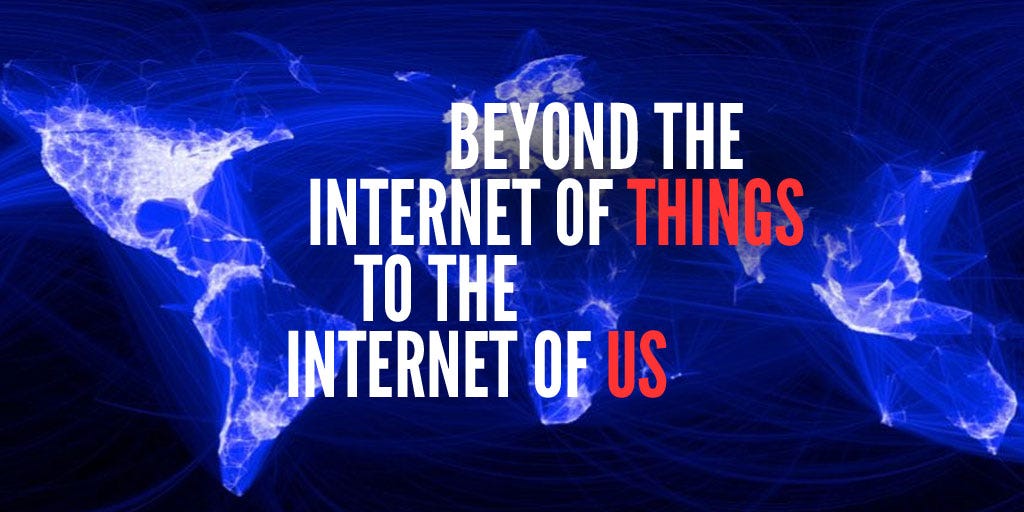
As amusing or inspiring as the thought experiment about interstellar travel for SIMs might be, there’s another evolutionary path for human beings right here on planet Earth that is no less radical, and arguably more profound: the meeting of human minds.
In the early 2000s Dr. Phillip Alvelda and I worked at two different companies on the earliest attempts to put video on mobile phones. Today our radical notion has become reality: more than 70 percent of the 2 billion people who own smartphones use them to record and share photos and video. Why is this important? It’s been my lifelong passion to use technology to connect people and thereby melt down the barriers of indifference, ignorance, and prejudice. Mobile video is a small step in that direction. Sure, we get a lot of silly pet tricks and StyleHaul videos posted to YouTube, but we also get to experience a great deal more, such as:
> The faraway has become near. Today anybody with an Android phone has the ability to share, instantly, what she is seeing with another person in another part of the world. As recently as the 1990s this was impossible without a satellite truck. Now we all carry the capability in our pocket.
> The extraordinary has become ordinary. It has become commonplace to see video clips of amazing feats of human performance and physical prowess.
> Expert knowledge has become accessible to all. Today there’s a video tutorial on YouTube for nearly any skill a person might wish to acquire.
Mobile video gives us all the ability to see through the eyes of others who are nowhere near us and whose lives are nothing like ours. We access radically different perspectives every day just by glancing at the devices in our palms.
The Networked Mind
DARPA legend has it that Bob Metcalfe, an electrical engineer, was watching two scientists working on a computer that kept crashing and wondered, “What happens when we connect two of these things together?” That spark of curiosity led to Ethernet, computer networking, and Metcalfe’s law. Now fifty years later, DARPA is doing it again without the computer. Imagine for a moment what might happen if researchers succeed in networking our minds. As one scientist at the DARPA event described it, “You might choose to let someone else in another part of the world see through your eyes.” The concept is mind-bending. Literally.
Randal Koene commented: “It is cool that SIM can allow millennia of space travel and living in non-Earthlike places, but there is a third very important aspect that makes SIM hugely important, namely the connections between us.
“Much of what we think of as progress, civilization, and human development has been achieved through ever-greater and better communication,” he explained. “From expressions to language to writing to recordings to the Internet, we keep connecting more people more intimately at greater speed. (Is that right? You really think that the internet has made us more connected? You are an idiot. The internet has made us much more disconnected. People don’t even know how to talk to each other anymore. They text, because it keeps them isolated/insulataed. They sit across from each other at the table and text. IT is insane. There is more discord, more hatred, more anger today than at any other point in my lifetime.) I think that builds not just collaboration, but empathy, and thereby higher forms of culture. With SIM, we can take that even further.” (Higher forms of culture… we have so deteriorated as a society. There is no respect anymore, people have no idea how to behave, people are so confused they don’t even know what sex they are. We have lost all sense of family, of truth, of morality.)
Whole brain emulation promises to free humanity of more than the constraints of time and space. It will also relieve us of skull-bound isolation. As much as we love our bodies, they limit us in ways that we can barely recognize because we cannot conceive of an alternative. Every sensation that a human being experiences, from emotion and understanding to memories and philosophical musings, is bound up inside the skull. (wrong, the brain is not where you emotions, your memories, you connectivity originates. It is in your spirit.) It remains incredibly difficult for us to convey what we experience inside this three-pound lump of gray matter. The networked mind would free us to share the inexpressible.
This post is an excerpt from Vaporized by Robert Tercek.
For more related information visit the following posts:

